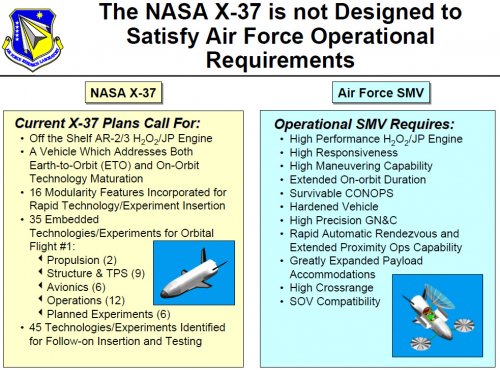R
RGClark
Guest
Byeman said:Once again, you use unrelated internet data to "prove" a wrong conclusion
A. X-37 is not X-40
B. X-37 does not have a delta-V of 3,100 m/s
C. You have no proof that X-37 has imaging equipment
D. It isn't complicated to figure out that you do know what you are talking about. You keep trying to find forums where you think people will listen to you but you are no different than the guy who stands on the street corner yelling at people.
See here for how the X-40 program became the X-37 program:
Boeing X-37 / X-40.
http://www.designation-systems.net/dusrm/app4/x-37.html
Nobody knows, outside the classified program, what its delta-V capability is because it hasn't been released. Since this is not a completely operational system it's likely to be less than 3,100 m/s but nobody knows how much less. Interestingly, it might be possible to estimate its delta-V capability from the size of the propellant tanks and knowing which fuel/oxidizer is being used:
Air Force's X-37B Secret Space Plane.
http://www.uaff.us/secret_spacecraft.htm
This page though is giving the fuel as kerosene. Some other sources say this was changed to hydrazine, or the military equivalent of that.
Look up references to the X-37b. It's meant to serve as a test platform for such imaging capabilities in addition to testing capabilities required of a reusable spacecraft. It would be hard to imagine testing such imaging capabilities without giving the craft the ability to do some type of imaging.
Bob Clark

